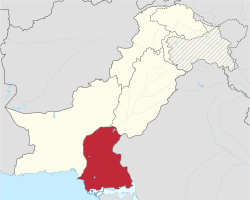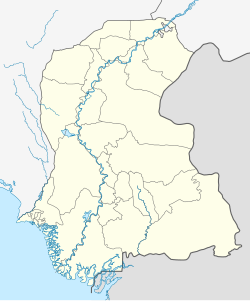Sindh
Sindh سنڌ سندھ | |
|---|---|
 Ranikot Fort "(Great Wall of Pakistan)". | |
 Location of Sindh within Pakistan | |
 Map of Sindh, Pakistan | |
| Coordinates: 24°52′12″N 67°33′00″E / 24.87000°N 67.55000°ECoordinates: 24°52′12″N 67°33′00″E / 24.87000°N 67.55000°E ⧼validator-fatal-error⧽ | |
| Country | Pakistan |
| Established | 1 July 1970 |
| Capital | Karachi |
| Largest city | Karachi |
| Government | |
| • Type | Province |
| • Body | Provincial Assembly |
| • High Court | Sindh High Court |
| Area | |
| • Total | 140,914 km2 (54,407 sq mi) |
| Population (2012 census preliminary)[1] | |
| • Total | 55,245,497 |
| • Density | 390/km2 (1,000/sq mi) |
| Time zone | UTC+5 (PKT) |
| Main Language(s) | Other: Punjabi, Pashto, Balochi, Saraiki[2][3][4] |
| Assembly seats | 168[5] |
| Districts | 27 |
| Towns | 119 |
| Union Councils | 1108[6] |
| Website | sindh.gov.pk |
Sindh (Sindhi: سنڌ) (Urdu: صوبہ سندھ) is a province in Pakistan. The provincial capital of Sindh is Karachi. Sindh has a population of 30 million people and an area of 54,407 mi² or (140,914 km²); in terms of area the provincial region of Sindh is greater in area than Greece but smaller than Tajikistan. There is a southern boundary with the Indian state of Gujarat. This is in dispute see: Kori Creek
Etymology[edit]
The province of Sindh and the people inhabiting the region are named after the river known as the Sindhu River before Independence and now called the Indus River. In Sanskrit, síndhu means "river, stream", and refers to the Indus river in particular. The Greeks who conquered Sindh in 325 BC under the command of Alexander the Great rendered it as Indós, hence the modern Indus. The ancient Iranians referred to everything east of the river Indus as hind from the word Sindh. When the British arrived in the 17th century, they followed that regional example and applied the Greek name for Sindh to the entire South Asian region, calling it INDIA. The word Sindh is a Persian derivative of the Sanskrit term Sindhu, meaning "river," a reference to the Indus River.[7] Southworth noted that the name Sindhu is in turn derived from Cintu, a Dravidian word for Date palm, a common tree abundantly found in Sindh.[8][9] The previous spelling Sind (from the Perso-Arabic سند) was discontinued in 1988 by an Amendment passed in the Sindh Assembly.[10]
Sindhi history[edit]
Sindh (Sindhi: سنڌ) is one of the provinces of Pakistan. Sindh was home to one of the world's oldest civilizations, the Indus Valley Civilization which is 5,500 years old. 'Hind' is the corruption of the word for 'Sind'. On the 26th of June in 1947 Sindh joined Pakistan by a majority vote of members of the 1947 provincial legislature.
Geography[edit]
Sindh is located on the western corner of South-central Asia, bordering the Iranian plateau in the west. Geographically it is the third largest province of Pakistan, stretching about 579 km from north to south and 442 km (extreme) or 281 km (average) from east to west, with an area of 140,915 square kilometres (54,408 sq mi) of Pakistani territory. Sindh is bounded by the Thar Desert to the east, the Kirthar Mountains to the west, and the Arabian Sea in the south. In the centre is a fertile plain around the Indus River.
Districts of Sindh[edit]
Government[edit]
The Provincial Assembly of Sindh is unicameral and consists of 168 seats, of which 5% are reserved for non-Muslims and 17% for women. The provincial capital of Sindh is Karachi.
The government is presided over by the Chief Minister of Sindh.
Most of the Sindhi people in the province are involved in Pakistan's politics. Sindh is a stronghold of the centre-left Pakistan Peoples Party (PPP), which is the largest political party in the province.
Pakistan has had two very famous Sindhi leaders as Prime Ministers—Mr Zulfiqar Ali Bhutto and his daughter Ms Benazir Bhutto. Ms Bhutto's husband, Mr Asif Ali Zardari, was elected President of Pakistan.[11]
| Provincial flag | Flag of Sindh | |
|---|---|---|
| Provincial seal | Emblem of Sindh | 
|
| Provincial animal | Sindh Ibex[12] | 
|
| Provincial bird | Black wood partridge[12] | |
| Provincial fish | Catla | |
| Provincial crop | Cotton | |
| Provincial flower | Nelumbo indica[12] | |
| Provincial tree | Neem[12] | 
|
| Provincial fruit | Watermelons | |
| Provincial dish | Sindhi biryani | |
| Provincial dance | Sufi dance | |
| Provincial instrument | Yaktaro | |
| Provincial sport | Malakhra |
Related pages[edit]
 Media related to Sindh at Wikimedia Commons
Media related to Sindh at Wikimedia Commons
Further reading[edit]
- Mubarak Ali (ed.). "Sindh Observed" (PDF). Selection from the Journal of Sindh Historical Society.[permanent dead link]
References[edit]
- ↑ "Sind - type and level of administrative division". World Gazetteer. Archived from the original on 2012-12-08. Retrieved 2009-08-19. Unknown parameter
|url-status=ignored (help) - ↑ "Percentage Distribution of Households by Language Usually Spoken and Region/Province, 1998 Census" (PDF). Pakistan Statistical Year Book 2008. Federal Bureau of Statistics - Government of Pakistan. Archived from the original (PDF) on 18 November 2008. Retrieved 15 December 2009. Unknown parameter
|url-status=ignored (help) - ↑ "Sindh (province, Pakistan)" at Britannica Online Encyclopedia
- ↑ "About Sindh Archived 2010-06-20 at the Wayback Machine" at SindhToday.net
- ↑ "Provincial Assembly Seats".
- ↑ "Government of Sindh". Archived from the original on 2019-06-16. Retrieved 2012-04-06. Unknown parameter
|url-status=ignored (help) - ↑ Phiroze Vasunia 2013, p. 6.
- ↑ Southworth, Franklin. The Reconstruction of Prehistoric South Asian Language Contact (1990) p. 228
- ↑ Burrow, T. Dravidian Etymology Dictionary Archived 1 March 2021 at the Wayback Machine p. 227
- ↑ "Sindh, not Sind". The Express Tribune. Web Desk. 12 February 2013. Retrieved 16 October 2015.
- ↑ The prime minister is the 'head of government' under the Constitution of Pakistan whereas the president is 'head of state'
- ↑ 12.0 12.1 12.2 12.3 Cite error: Invalid
<ref>tag; no text was provided for refs namedwiisymbols - ↑ "1998 Census Data". Archived from the original on 2014-07-19. Retrieved 2017-12-05. Unknown parameter
|url-status=ignored (help)
Other websites[edit]
- "Sindh at a glance". Pakistan Almanac.


